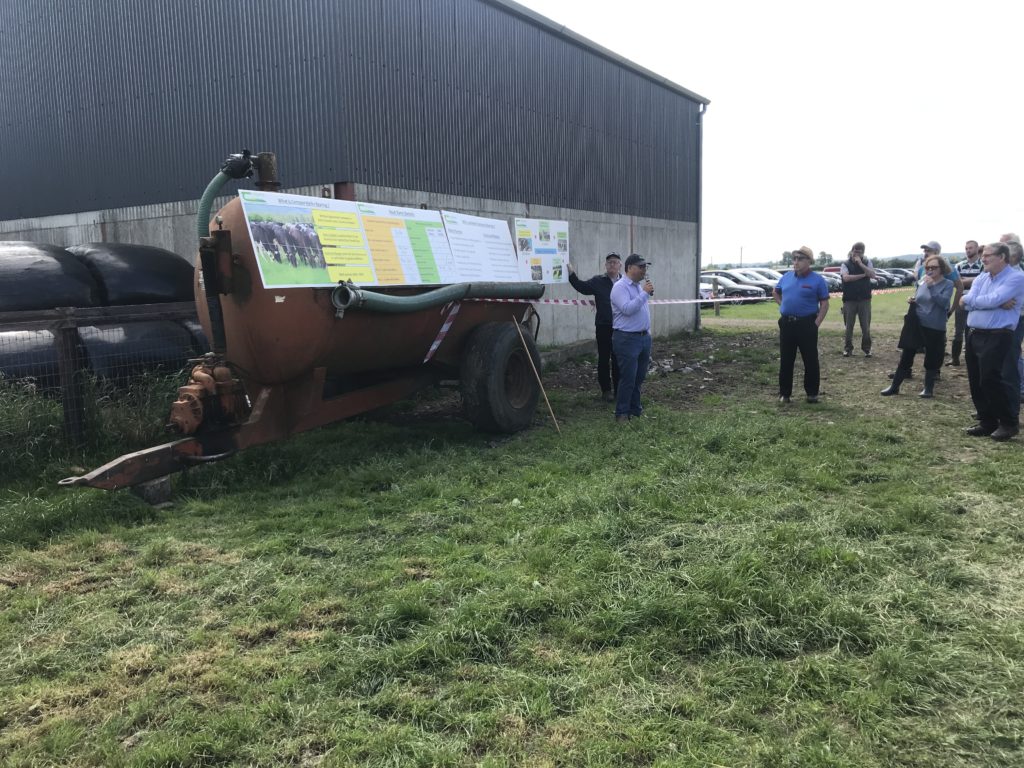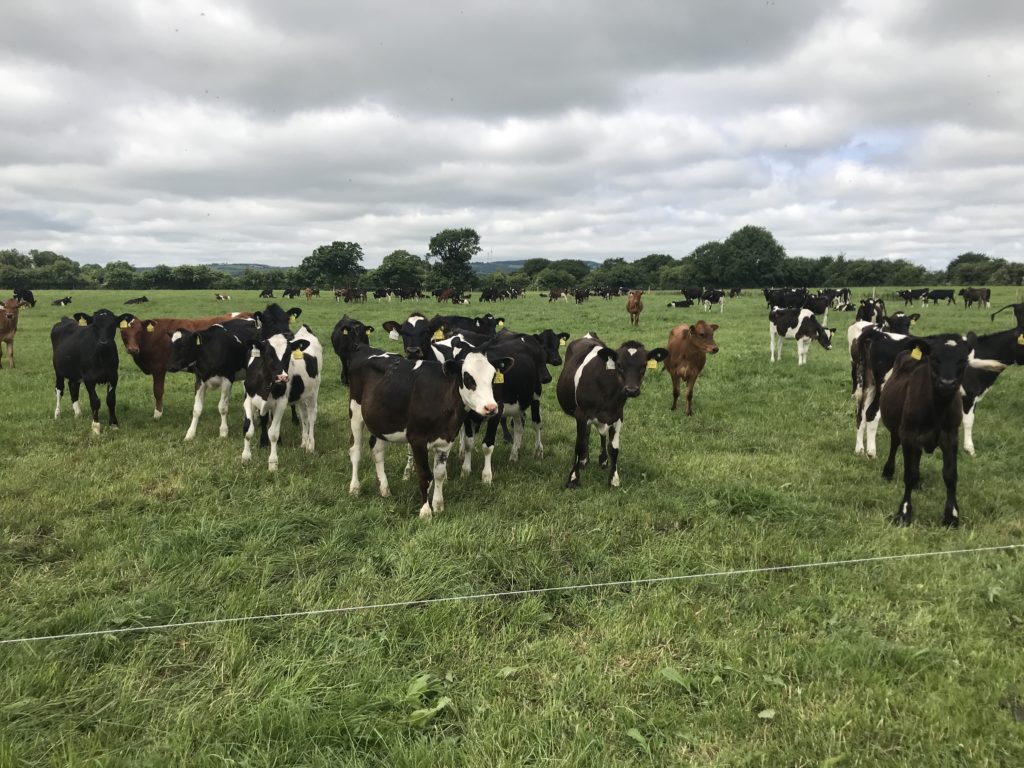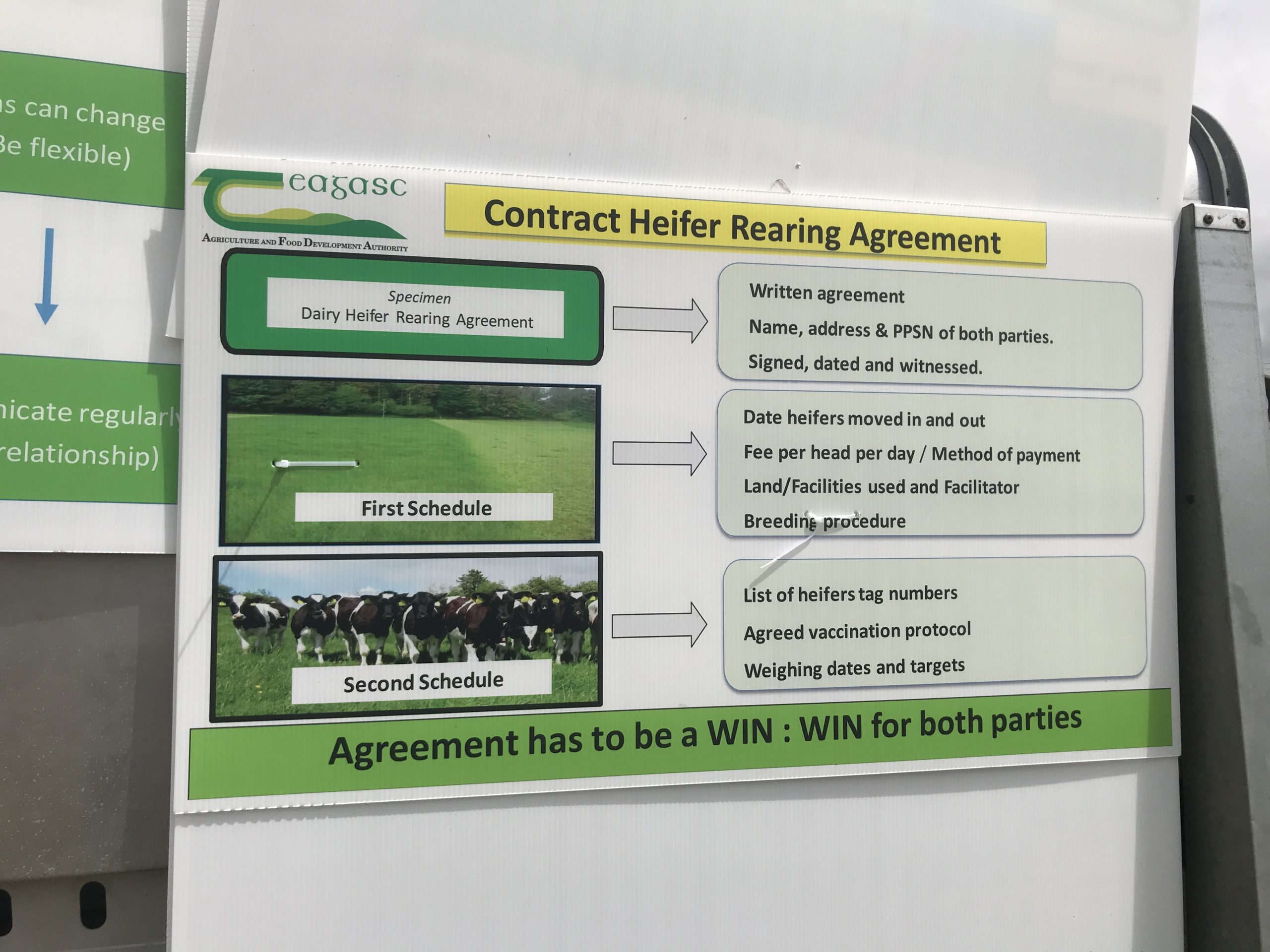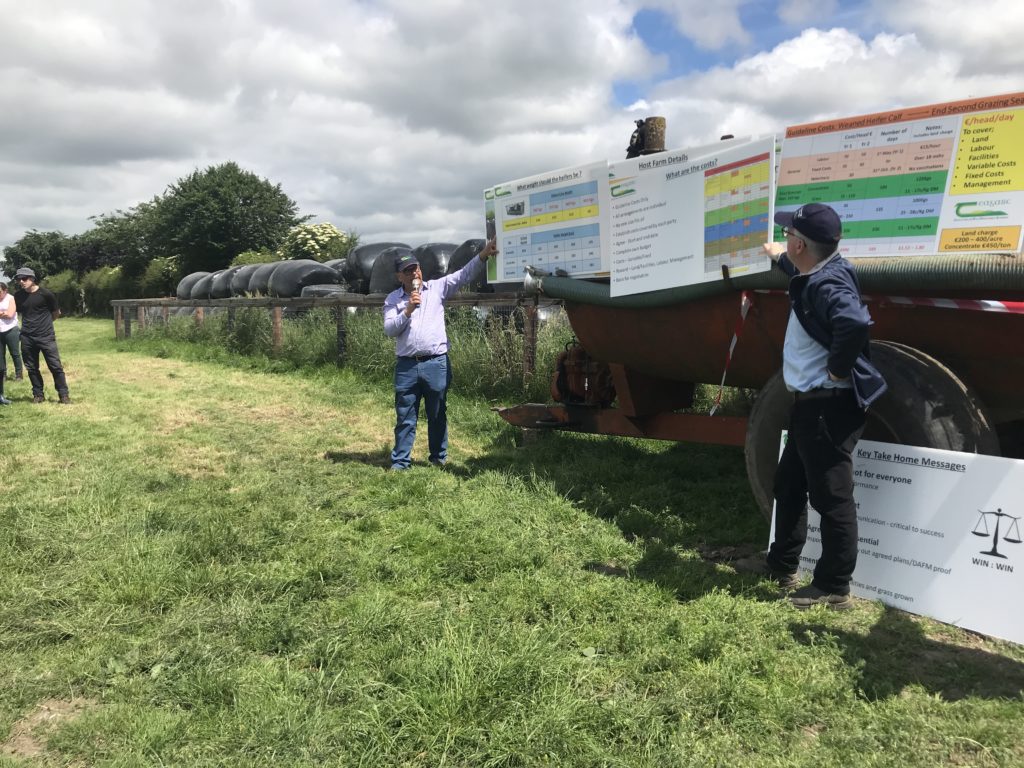Contract rearing of dairy heifers continues to be in growing demand, with both dairy and dry stock farmers potentially benefiting from the arrangement.
Earlier this week, Teagasc held a farm walk on the farm of Laurence McEvoy, a contract-rearer based in Ballyragget, Co. Kilkenny.
The farm walk looked at a number of topics, including:
- Why consider contract heifer rearing?;
- The requirement for a successful agreement;
- Health issues and other concerns;
- And costs.
Contract rearing
Laurence had operated a number of different beef enterprises before contract rearing for a dairy farmer.
He farms a total of 56ha, with 170 heifer calves and 156 in-calf heifers all from the same herd.
Speaking at the event, Terry Carroll from Teagasc gave a brief overview of what contract rearing is and how it can be a win-win situation for both farmers involved.
“Contract rearing is an agreement between two farmers, where one of the farmers rears the heifers for another farmer – usually a dairy farmer,” he said.
“The dairy farmer supplies a heifer to be reared at an agreed fee/head/ day.
“The contract rearer cares for and returns to the dairy farmer an in-calf heifer in good condition at the agreed time.”

Why contract rearing?
Gordon Peppard from Teagasc spoke about why dairy farmers should consider looking at contract rearing their heifers, and why dry stock farmers should consider rearing heifers for dairy farmers.
“Since the removal of milk quotas in 2015 there has been great opportunity for growth on dairy farms,” he said.
“So if dairy farmers can replace the heifers on the milking platform with milking cows there is great opportunity to increase output and scale on farms.
“It simplifies the system on dairy farms, with less groups, and reduces the labour requirement.”
Continuing, Gordon said: “On a lot of dairy farms the milking parlour or cubicle shed has been improved, but the accommodations or facilities for heifers have not.
“A big one that is coming to the fore now is land availability and the new nitrates for dairy cows from next year onwards.
“This is going to mean that more land will be required to carry the same stocking rates on farms, so removing these youngstock from the farm will help.
“Finally, it can improve the work-life balance of dairy farmers.”
Gordon then discussed how it can benefit a dry stock farmer that is looking at contract rearing.

“It can compliment your existing farm enterprise; you might have a system already on the farm with scope to expand,” he said.
“But with voliate markets it may not suit, so contract rearing may be a supplementary enterprise that can come onto your farm.
“It may be a potential way to increase your stocking rate and output, which may potentially make the farm more profitable,” he added.
“The one thing that a lot of contract rearers will say to me [is a positive] is the regular cashflow – a lot of beef farmers sell cattle only a small number of days in the year.
“That means they are dependent on the price on that particular day and if it is a bad price or the sale goes bad they may be stuck with that price.
“Where in a contract rearing situation you know what is coming in each month, allowing you to manage your cashflow.
“It also means that for some farmers there is no need to invest in stock and they are working with more docile animals,” Gordon added.

Grass
The importance of grassland management on contract-rearing farms was highlighted at the event.
It was noted at the event that Laurence stops feeding the calves meal two weeks after they arrive on the farm.
This is achievable by excellent grassland management and having good grazing infrastructure in place on the farm.
Laurence grazes all the heifer calves and yearling heifers in the same group, which means 170 heifer calves and 156 in-calf heifers are in two groups.

Speaking at the event, Laurence said that management of these groups is much easier compared to when he was a suckler farmer.
“I grew a lot of extra grass in the last three years because of only having the two groups,” he said.
“From now on I will be using a lead-follower system with the calves. When the calves first came they were on old pasture with a little bit of stem.
“The calves are only on leafy grass for the last 10 days or so – this is to prevent any issues with the calves’ stomachs.
“I let the calves into new grass earlier in the year and within 24hrs, I had my first case of bloat.
“I have found that older grass is much better for younger calves, their stomachs aren’t fully developed so they can’t handle that leafy grass.”

Continuing, Laurence said: “The calves get what they need in their first year at grass and then I use the in-calf heifer to clean out paddocks.
“I won’t religiously follow a leader-follower system, because the calves get what they need in the first year at grass,” he added.
Terry Carroll from Teagasc spoke about stocking rates that can be carried on this system and how important it is to know how much grass your farm is growing.
Terry highlighted that the stocking rate on the farm will determine the amount of grass required to been grown.
A 20ha farm with a stocking rate of 130 units of organic nitrogen (N)/ha will require 7.25t/ha to be grown. If the stocking rate changes to 170 units of organic N/ha, it will require 9.5t/ha, while a stocking rate of 210 units of organic N/ha will require 11.75t/ha to be grown.
“We make no bones about it, the success of this enterprise will be determined by how good you are at growing grass,” Terry said.

Risk management
At the event the importance of risk management when setting up an agreement was also highlighted, particularly around disease and bovine tuberculosis (TB).
A number of Department of Agriculture, Food and the Marine (DAFM) vets spoke at the event about risk management. They agreed that disease risks should be considered before setting up an agreement with another farm.
They said that all possible disease issues should be considered before setting up an agreement and that plans are in place should there be a disease issue on one, or both farms.
They noted that animals that are TB restricted can return to a herd that is TB free, but that both herds would then be restricted.
It was advised that there is an agreement in place before an issue arises, rather then dealing with an issue once it has risen.

Successful contract rearing agreement
Gordon Peppard then spoke about what makes a successful contract-rearing agreement.
Gordon began: “Ideally it is a written agreement, and the best agreement are the ones that are written at the start and don’t need to be looked at again.
“What makes makes a good agreement firstly, is partnering with the right person – ideally someone you know that you work with and get on with.
“Agree on each other’s responsibilities and ensure they are set out in the agreement and carry out your agreed plans and expect the same from your opposite party.”

Continuing, he said: “It’s a bit like a marriage; things change, things will go wrong, there will be problems.
“But it is how you get through those problems that will determine the success of this agreement.
‘”It’s very important to continue to communicate with your partner and have plans for when things go wrong.
“It needs to be a win-win situation for both parties.”
Gordon then outlined what should be included in the agreement: Names, addresses and PPSN numbers of both parties; the date the heifers arrive and leave farm; and the fee/head/day and method of payment.
The land and facilities that are used, along with the breeding policy that will be used, should also be included, as well as a vaccination programme, weights, dates and targets.
Gordon recommend that the contract rearer and dairy farmer have a facilitator that both parties can talk too.


Cost
The final stand on walk was on the cost of contract rearing and what should be charged for rearing calves.
It was noted these are guideline figures and that some farmers may be getting more, while other may be getting less.
It was also noted that everyone needs to establish their own costs based on start and finish date, number of heifers and more.
Contract rearers need to cover variable and fixed costs, along with being reward for being a contract rearer.
The price/head/day has to cover land, labour, facilities, variable and fixed costs and management.
The figures that were given on the day, based on a weaned heifer on-farm from May 1 to November 1, were €836-990.
On a cost/head/day basis this is €1.52-1.80; these figures are based on current costs.
Commenting, Gordon said: “We are not price setters, we are just giving the facts and information.
“We are giving you a guideline price to go away and discuss with the other person in agreement and a price can then be agreed.
“Every agreement is different, so this needs to be taken with pinch of salt and watch what is happening in your own scenario.”

Take-home message
Contract rearing is not for everyone, you need to be able to achieve a high level of performance.
The business agreement, trust, compromise and communication is critical for success.
A written agreement is essential, to agree responsibilities and carry out agreed plans.
Management, matching stocking rates to facilities and grass growth rates on farm should all be kept in mind throughout the agreement process.
